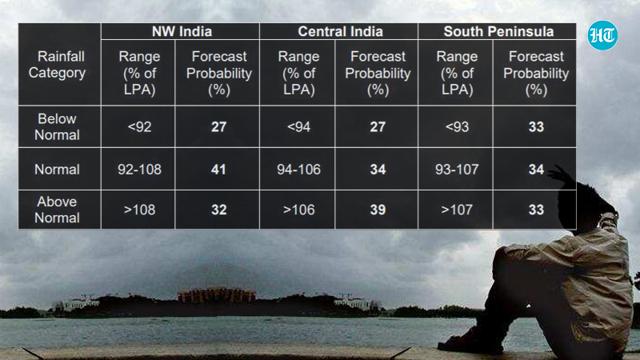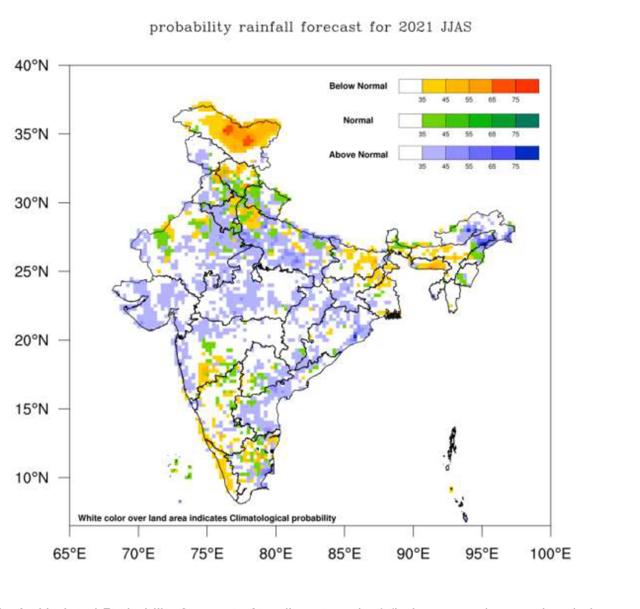Monsoon rainfall, a key variable in the health of the rural economy, is likely to be normal at 101% of the long-period average (LPA), the India Meteorological Department (IMD) said in its second-stage long-range forecast on Tuesday. There is a 40% probability that is likely to be 96% to 104% of LPA, or the average rainfall (88cm) recorded from 1961 to 2010. In its first-stage monsoon forecast in April, IMD said the rainfall was likely to be 98% of LPA after two years of above-average rainfall.
The monsoon arrives first in Kerala around June 1. It is expected to cover the rest of the country by July 5. The monsoon onset has been delayed by two days, IMD said in its revised forecast on Sunday. IMD previously said that the start of the monsoon would be on May 31, a day ahead of schedule.
India receives about 70% of its annual rainfall during the four-month season that is crucial for the country’s farm-dependent economy and for rice, soybeans, and cotton cultivation. A normal monsoon this year will significantly help the agriculture sector. Good rains have been a prime reason for the farm sector’s resilience for two years despite the pandemic. India has over 150 million farmers and nearly half of Indians are dependent on a farm-based income. As much as 60% of India’s net-sown area does not have access to irrigation.
Agriculture is one of the mainstays of its economy. Monsoon spurs farm produce and improves rural spending. The monsoon impacts inflation, jobs, and industrial demand. Good farm output keeps a lid on food inflation. Ample harvests raise rural incomes and help inject demand into the economy. Nearly half of India’s population depends on a farm-based livelihood. The monsoon also replenishes 89 nationally important reservoirs critical for drinking and power generation.

M Mohapatra, IMD director-general, said they use multi-model ensemble forecasting which considers projections from the best models and that the forecasts are better and more accurate closer to monsoon. “The first stage forecast was issued in April and then we monitored the conditions for entire May and found that monsoon is likely to normal and spatially well distributed,” he said.
Northwest India is likely to record normal rain at 92 to 108% of LPA. Central India is likely to record above-normal rain of over 106% of LPA. Southern Peninsula is likely to record between 93 to 107%. Northeast India is expected to record below normal rain at less than 95% of LPA.
For the first time, IMD has issued a special monsoon forecast for the monsoon core zone stretching from Odisha to Maharashtra and Gujarat, where agriculture is largely rainfed. In the monsoon core zone, monsoon rain is likely to be above normal over 106%.

IMD said the monsoon is likely to be well distributed spatially across the country. “Most parts of the country are expected to receive normal to above-normal rainfall during the season,” IMD said in a statement.
Normal to above normal rain is likely in June at 92% to 108% of LPA. The spatial distribution for June suggests above normal rainfall probability over most areas of eastern parts of central India, along the planes of the Himalayas and east India. Below normal probability is likely in northwest India and southern parts of the peninsula and some areas of northeast India.
IMD said La Niña conditions, which are associated in India with strong monsoon and above-average rains and colder winters, turned neutral in April end. The El Niño Southern Oscillation (ENSO), a periodic fluctuation in sea surface temperature and the air pressure of the overlying atmosphere across the equatorial Pacific Ocean, is neutral. It is likely to continue over the equatorial Pacific Ocean through the monsoon.

ENSO has a major influence on weather and climate patterns such as heavy rains, floods, and drought. El Niño has a warming influence on global temperatures. In India, El Niño is associated with drought or weak monsoon.
The 2020-2021 La Niña event has ended and neutral conditions (neither El Niño nor La Niña) are likely to dominate the tropical Pacific in the next few months, World Meteorological Organization said on Tuesday. Air temperatures are expected to be above average between June and August, especially in the northern hemisphere. There is very little chance of El Niño conditions developing now.
Mohapatra said ENSO neutral conditions are associated with normal monsoon years. “We are also expecting above average rains in the core monsoon zone and over central India. This happens when the monsoon trough is active and low-pressure areas develop over the Bay of Bengal. We have to see if that is happening. From models, it appears to be a good year.”
He said the monsoon is a dynamic system. “On May 15, we had said its onset is likely around the normal date of June 1. But the criteria for declaring monsoon were not fulfilled. Now conditions are very gradually becoming favourable, and we are expecting the onset of monsoon around June 3.”
G V Ramanjaneyulu, executive director, Centre for Sustainable Agriculture, Hyderabad, said good rains in the Kharif season are good news. He added but because of the lockdown and the second pandemic wave of the pandemic getting labour and inputs for sowing has become difficult. “We have also seen prices of various farm produce have come down in many rural areas. Health costs have increased because of Covid-19. Farmers will need support to repay loans. It is a good sign that at least rains will be normal during this distressing period.”
Leave a Comment